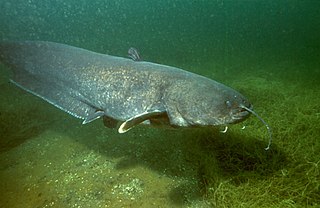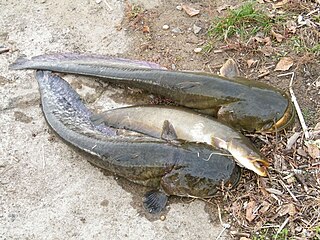
The walking catfish is a species of freshwater airbreathing catfish native to Southeast Asia. It is named for its ability to "walk" and wiggle across dry land, to find food or suitable environments. While it does not truly walk as most bipeds or quadrupeds do, it can use its pectoral fins to keep it upright as it makes a wiggling motion with snakelike movements to traverse land. This fish normally lives in slow-moving and often stagnant waters in ponds, swamps, streams, and rivers, as well as in flooded rice paddies, or temporary pools that may dry up. When this happens, its "walking" skill allows the fish to move to other aquatic environments. Considerable taxonomic confusion surrounds this species and it has frequently been confused with other close relatives. One main distinction between the walking catfish and the native North American ictalurid catfish with which it sometimes is confused, is that the walking catfish lacks an adipose fin. It can survive 18 hours out of water.

The wels catfish, also called sheatfish or just wels, is a large species of catfish native to wide areas of central, southern, and eastern Europe, in the basins of the Baltic, Black and Caspian Seas. It has been introduced to Western Europe as a prized sport fish and is now found from the United Kingdom east to Kazakhstan and China and south to Greece and Turkey.

Siluridae is the nominate family of catfishes in the order Siluriformes. About 105 living species of silurids are placed in 12 or 14 genera.

Synodontis membranaceus, known as the moustache catfish, is a species of upside-down catfish that is native to northern Africa. It was first described by French naturalist Geoffroy Saint-Hilaire in 1809 as Pimelodus membranaceus, from specimens obtained in the Nile River. The species name membranaceus refers to membranes present on the barbels of the fish.

Synodontis nigrita, known as the false upside down catfish, is a species of upside-down catfish that occurs widely in northern Africa. It was first described by French zoologist Achille Valenciennes in 1840. The type specimen is in the Muséum National d' Histoire Naturelle de Paris.
Synodontis ruandae is a species of upside-down catfish native to Rwanda, Burundi, and Tanzania where it is found in the Kagera River system. It was first described by Belgian ichthyologist Hubert Matthes in 1959, based upon holotypes discovered in the Kagera River at Rusumo, Rwanda. The specific name "ruandae" is derived from its type locality, Rwanda.

The Lake Victoria squeaker is a species of upside-down catfish that is native to Kenya, Burundi, Tanzania and Uganda where it is found in Lakes Kioga and Victoria and the Victorian Nile in the lower Kagera River and the Malagarasi River drainage. It was first described by British-Belgian zoologist George Albert Boulenger in 1906, from specimens collected in the Lake Victoria at Buganga, Uganda and Entebbe, Uganda by Mr. E. Degen. The species name victoriae is derived from the location where the species was originally discovered, Lake Victoria.

Synodontis petricola, known as the cuckoo catfish, or the pygmy leopard catfish, is a species of upside-down catfish endemic to Burundi, Zambia, the Democratic Republic of the Congo, and Tanzania where it is only known from Lake Tanganyika. It was first described by Belgian ichthyologist Hubert Matthes in 1959. The species name "petricola" is derived from a combination of the Latin petra, meaning stone or rock, and the Latin cola, meaning inhabitant. This refers to the rocky environment where this species is found.

The broadhead catfish is an economically important air-breathing catfish that is a native of Southeast Asia. The fish is farmed in ponds for use in human consumption in countries such as Thailand and the Philippines. However, native populations now face extinction due to man-made activities and genetic introgression due to interbreeding with escaped aquaculture hybrids.

Clarias gariepinus or African sharptooth catfish is a species of catfish of the family Clariidae, the airbreathing catfishes.

Synodontis caudovittatus, known as the white-finned synodontis, is a species of upside-down catfish that is native to the Nile basin of Ethiopia, South Sudan, and Sudan. It was first described by British-Belgian zoologist George Albert Boulenger in 1901, from specimens collected in the White Nile, at the mouth of Lake No in South Sudan. The species name caudovittatus comes from the Latin word cauda, meaning "tail", and the Latin word vitta, meaning "stripe" and refers to the coloration of the tailfin.

Synodontis clarias, known as the red tailed synodontis, or the mandi, is a species of upside-down catfish that occurs widely in the waters of northern Africa. It was first described by Swedish zoologist Carl Linnaeus in 1758 as Silurus clarias. The original specimens were obtained in Egypt, near Cairo. The meaning of the species name clarias is not certain, but may possibly have been used to mean "bright" or "clear".

Synodontis frontosus, known as the Sudan squeaker, is a species of upside-down catfish that is widely distributed throughout northern and central Africa. It has been reported in Chad, Democratic Republic of the Congo, Ethiopia, Kenya, Somalia, Sudan, and Uganda. It was first described by French zoologist Léon Vaillant in 1895, from specimens collected in the White Nile in Sudan. The species name frontosus is Latin, and means "broad head".

Synodontis macrostigma, known as the largespot squeaker, is a species of upside-down catfish that is native to Angola, Botswana, Namibia, South Africa and Zambia where it is found in the Cunene, Okavango, upper Zambezi and Kafue River systems. It was first described by British-Belgian zoologist George Albert Boulenger in 1911, from specimens collected in the Okovango River, Botswana, by R. B. Woosnam. The species name macrostigma is derived from the Greek word makros, meaning "large", and the Greek word stigma, meaning "mark" or "spot" and refers to the large spots on the sides of the fish.
Synodontis marmoratus is a species of upside-down catfish that is native to Cameroon where it is found in the Sanage and Nyong Rivers. It was first described by Swedish zoologist and conservationist Einar Lönnberg in 1895, from a specimen collected from Bonge, Cameroon.

Synodontis nigromaculatus, known as the spotted squeaker, the blackspotted squeaker, or the speckled squeaker, is a species of upside-down catfish that is found widely in southern Africa. It has been identified in Angola, Botswana, the Democratic Republic of the Congo, Mozambique, Namibia, South Africa, Zambia, and Zimbabwe. It was first described by British-Belgian zoologist George Albert Boulenger in 1905, from specimens collected in Lake Bangweulu in Zambia.

Synodontis resupinatus is a species of upside-down catfish that is native to the Niger basin and the Bénoué River of Cameroon, Mali, and Nigeria. It was first described by British-Belgian zoologist George Albert Boulenger in 1904, from specimens obtained near Lokoja, Nigeria.

Synodontis zambezensis, known as the brown squeaker, the korokoro, or the plain squeaker, is a species of upside-down catfish that is native to the middle and lower Zambezi River system of Eswatini, Mozambique, South Africa, Tanzania, Zambia and Zimbabwe. It was first described by German naturalist and explorer Wilhelm Peters in 1852, from specimens collected in the Zambezi River in Mozambique. The species name zambezensis is derived from the Zambezi River, where this species is found.

The vundu is a species of large airbreathing catfish found widely in rivers and other freshwater habitats of sub-Saharan Africa, as well as the Nile. It is also called the sampa, cur, lenda, or certa.

Silurus soldatovi, Soldatov's catfish or northern sheatfish, is a large catfish species from the Far East.



















